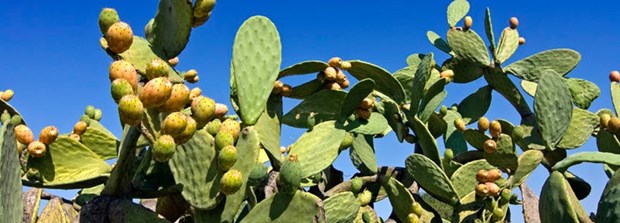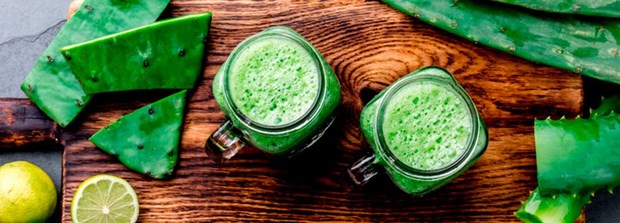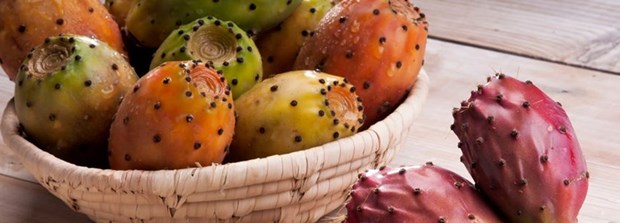What is Prickly Pear? 26 interesting facts and figures about this delicious fruit used in several Mexican specialities and beverages.
Aztec. It is believed that the name of
the ancient city of "Tenochtitlan" (today’s Mexico City) derives from
"tetl" (meaning rock, stone) plus "nocthli", the Aztec name
for this fruit: so, literally, "Tenochtitlan" would seem to mean
"the place of the prickly pear at the foot of the rock". In fact,
following a prophecy, the Aztecs left Aztlàn and settled in a sacred place
which was supposedly announced by the vision of an eagle eating a snake on top
of a cactus plant: this image is the symbol of Mexico City today.
Blend. The taste of the prickly pear is
both strange and delicate, of varying intensities, recalling that of
strawberry, water melon and honeydew melon, with notes of fig, banana and
citrus fruits, as well as kiwi or persimmon.
Colonche. Also known as "cactus
wine", this is an ancient Mexican beverage (typical of the State of San
Luis Potosí), which is sweet and fizzy with a low alcohol content. It is made
by fermenting the pulp and juice of prickly pears of the red “cardona” variety
in wood barrels.
Distribution. Originating from Mexico, the
prickly pear became naturalized throughout the Mediterranean basin, especially
in Sicily, Sardinia and Malta, even spreading to Africa and the islands of
Madagascar, Reunion and Mauritius, Asia, Oceania and the temperate zones of
America. Today, it is also grown in the United States, in Chile, Brazil, North
Africa, Turkey, the Middle East and South Africa.
Eritrea. The prickly pear spread to the Horn
of Africa between 1890 and 1940 with the Italian colonization: apparently the
first cladodes to be imported came from Sardinia. Today, it infests entire
mountains of the highland areas and its fruit is known locally as
"beles": those who have tasted them say that the prickly pears of the
orthodox monastery of Debre Bizen (close to Nefasit) are particularly sweet and
juicy.
Fruit. Technically the fruit is berry, a
sweet fleshy one with numerous seeds. The appearance, weight and size of the
fruit vary according to its growth period. The first fruits are round and small
(with a more concentrated and assertive taste), while the later ones are larger
in size, elongated and pedunculated. The seeds of the fruit may also be used to
make a type of flour (gluten-free with excellent nutritional properties: it is
rich in iron, calcium, potassium and magnesium) and an oil (rich in linoleic
acid and vitamins E and K).

Prickly pear.
Gonzalo Fernández de
Oviedo y Valdés.
The Spanish naturalist to whom we owe the first detailed description of the
succulent bearing prickly pears: he described it in 1535 in his Historia
general y natural de las Indias.
Huevos rancheros con
nopales. A typical
Mexican dish which – according to tradition – consists in alternate layers of
tortilla, tomato sauce, fried eggs and more sauce (plus grated
"cotija" cheese, lime, avocado and coriander). There is another
popular version with sliced and grilled prickly pear cladodes, used in place of
tortilla.
It ingredient? Prickly pear cladodes could be the
next star of fine dining. In fact, the chefs are already using them in great
quantities: from Oysters with prickly pear jelly and ponzu sauce at the
acclaimed Nikkei restaurant (Dallas, Texas) to the Cladode confit with starred
anise of the Truss & Twine in Palm Springs (California), as well as
ice-cream flavours such as Nopales and lime from the Californian Puesto and
Fried cladodes filled with cheese and mushrooms in hot spicy sauce by the Flora
in Richmond (Virginia).
Junior League of
Phoenix. One of the best recipe "bibles"
dedicated to prickly pears is Pomegranates & Prickly Pears by the Junior
League of Phoenix: it presents over 250 traditional or creative recipes ranging
from salads and snacks to fine dining proposals (from starters to desserts).
Another in-depth and well thought out recipe selection (starters, soups,
salads, beverages, desserts, fancy breads and sweets) is the one signed by
Joyce L. Tate, collected in a classic by the Cactus and Succulent Society of
America: the Cactus Cookbook.
Kcal. 100 g of prickly pear
"count" for about 50 kcal. The nutrition chart also informs us that
the flesh contains a negligible quantity of fats and proteins, a fair amount of
carbohydrates and is a valuable source of minerals (potassium, calcium and
phosphorus) and vitamins such as A and C.
Liquors and
beverages. These
range from "tungi spirit" from the British Island of Saint Helena in
the Atlantic Ocean to the Sicilian digestive liqueur known as
"ficodi", without forgetting Malta’s ever popular "bajtra".
The analcholic drinks lovers can try the S. Pellegrino Fico d'India e Arancia,
a sweet and refreshing beverage mixing sweet orange juice with the flavour of
prickly pear, in dazzling cloudy-rose coloured drink.
Miel de tuna. Typical of the Mexican tradition,
this syrup is made by boiling prickly pear juice. Something similar is made in
Sicily, in Italy, and it looks rather like maple syrup.

Nopales Prickly pear.
Nopales. Another term for prickly pear
cladodes. To cook them, you need to remove all the thorns (as if you were
scaling a fish) and then peel them. After which, it solely depends on your
recipe: they can be cut into strips, diced ("nopalitos") or sliced
horizontally. They may be eaten raw in salads or cooked in fish, pork or
vegetable stews, but also boiled or fried, just as you would do with eggplants,
or grilled, preserved in brine or vinegar. They are also used to make jams and
candied fruit. And the most refined soups: such as Sopa de nopales by Angel
Vázquez of the Intro restaurant in Puebla (Mexico), who adds chilli pepper,
avocado, poached quail’s eggs and cojita cheese to diced cladodes.
Opuntia ficus-indica. The scientific name for this
succulent belonging to the cactacee family. Native to Mexico, it was already
grown and sold in the times of the Aztecs, who believed it was a sacred plant
with symbolic values. We find evidence of its importance, for example, in the
Mendoza Code dating back to 1540.
Pulp... addiction! Prickly pear pulp makes excellent
jam, jellies and preserves, sweets and refreshing or digestive beverages. It is
also excellent when reduced to a simple puree, whether sweetened with sugar or
not: at Oaxaca, for instance, they serve it in spoonfuls as a topping for
horchata (barley water).
Queso de tuna. Literally meaning "prickly
pear cheese": it is actually a sweet Mexican paste obtained by reducing
the juice of this fruit to a solid state by slow boiling. Then, when cool, the
semi-finished product is repeatedly bashed on a stone and then packaged in
rectangular boxes. It may also be aromatized with hazelnuts or pine nuts.
Risky business. Never touch a prickly pear with
bare hands, even if it already seems to be "dethroned": some of those
tiny, very fine spines with which it is covered – in tufts – can remain
attached to the peel and they are very sharp and unpleasant. It is advisable
when peeling it, to use rubber gloves all the time.
Sicily. Straw yellow in colour (but
pinkish-beige when crystallized): a rather special Sicilian prickly pear honey
is produced by the bees in the month of August in the areas around
Caltanissetta and Palermo. Rare and tricky to produce because it tends to
crystallize almost immediately, (even when still in the honeycomb at times), it
has a delicate scent and a very sweet taste with somewhat bitter notes
recalling the cladode. It teams up well with mature or intensely flavoured
cheese.
Tuna. This is the Spanish word for the
prickly pear fruit: hence the terms "queso de tuna" and "miel de
tuna" (see above).

Prickly pears varieties.
UFS. A recent study carried out by the
Biotechnology Department of the South African University of the State
(Bloemfontein) has thrown light on the health-giving benefits of prickly pears:
as well as the many nutritional properties of the pulp, the flowers can be used
for preparing herbal teas and infusions and the seeds for producing oils and
flours. A special flour can also be made from the cladodes: it is gluten-free,
rich in fibre and has proved to be excellent for making bread and cakes.
Varieties. There are three main varieties,
distinguishable thanks to the colour of their pulp: yellowy-orange (yellow
peel, with green streaks), red (ruby red pulp and peel) and white (creamy white
pulp and green peel). If you happen to visit Sicily where prickly pears enjoy
DOP status, they are respectively called "sulfarina",
"sanguigna" and "muscaredda". If, on the other hand, you
are in Mexico, the choice is still wider: there is the small red
"juana" (or "roja"), with a sharp taste, and the large
"roja pelona", which has no thorns and tastes like kiwi; there is the
sweet and juicy green "cristalina" (or "zarca": recalling
white peaches), and the vivacious "naranjona", with an almost spicy
taste of honey which recalls a mature persimmon at times. Then there are the
small wild varieties called "xoconostle" which are green in colour
with a sharp taste (of this variety, even the peel is added to stews), and the
red "cardona", with a bittersweet taste that is similar to a Luxardo
cherry. Floral hints characterize the orange variety known as "cuerno de
venado", while the yellow "platanera" is more tropical in
flavour (with hints of banana).
www.inmexico.com - Six intriguing ideas for
transforming prickly pears using the art of mixology: from a refreshing sangria
to a pink margarita, to a Mezcal mule, you will find them all here.
XVth and XVI
Centuries. It
would appear that the prickly pear cactus landed on the Old Continent from
Mexico in 1493 when Colombo made his return to Lisbon.
Youtube. On the well-known web platform,
there are more than 31,000 results relating to "prickly pear
recipes", you'll surely find the how-to video you're looking for here.
Zeffirelli. The prickly pear often appears in
the external shots of the film on the life of Jesus, as a characteristic
feature of the Palestinian flora at that time. However, this is an incredible
and constantly repeated anachronism that even the Italian film director Franco
Zeffirelli failed to spot when filming his “Jesus of Nazareth”.
By FDL